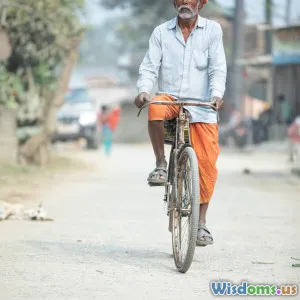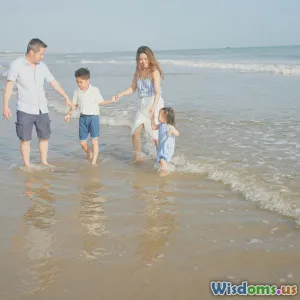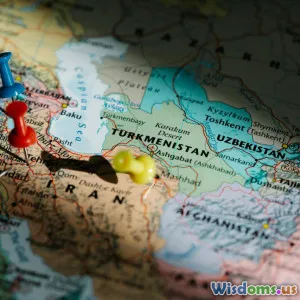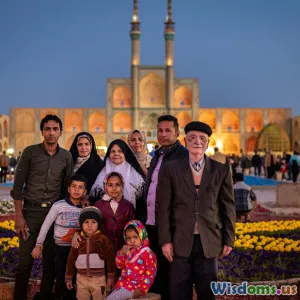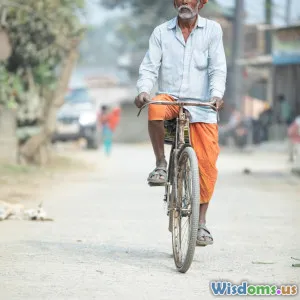
How to Make Friends on a Solo Expedition
15 min read Master the art of making real connections while traveling alone with practical strategies, examples, and inspiration for forging meaningful friendships on your next solo adventure. (0 Reviews)
How to Make Friends on a Solo Expedition
Embarking on a solo expedition conjures visions of wild landscapes, exciting discoveries, and, for many, the thrill (and anxiety) of navigating unknown territory alone. But what if the richest discoveries aren’t only the vistas or milestones, but the unexpected friendships forged along the way? Making friends while traveling solo can transform an adventure into a tapestry of human connection, resilience, and cultural exchange.
Whether you’re traversing the Andes, cycling through Vietnam, or wandering the streets of Marrakech, learning how to build meaningful connections can be just as rewarding as reaching your final destination. This guide shares practical strategies, real-world examples, and surprising insights to inspire confidence and authenticity on your solo journey.
Why Friendship Matters on a Solo Expedition
Going solo often means stepping out of your comfort zone — and that’s where genuine connection thrives. Loneliness can surface while traveling alone, but it doesn’t have to be your only companion.
A 2022 study by Hostelworld found that 64% of respondents prioritized social interaction when booking travel accommodations. An astonishing 54% of solo travelers described making new friends abroad as their favorite memory. Clearly, friendship isn’t just a bonus; it’s a motivator, support system, and portal into deeper understanding.
A real-world example: Melissa, a solo trekker from Canada, recalls joining a hostel-organized hike on her first day in Patagonia: “Conversation sparked so easily, since everyone was a little nervous. We bonded over shared trail snacks and sang folk songs. Some of those people are my closest friends now.”
The Myth of ‘Solo Means Alone’
Popular culture paints solo travel as a solitary pursuit — but the reality is more nuanced. While solo expeditions offer freedom and self-reflection, they frequently invite interactions impossible within group travel. Approaching a friendly stranger for help, savoring spontaneous cafe conversations, or accepting an invitation to a family dinner — these are the doorways to unforgettable experiences.
Preparation: Setting Yourself Up for Success
Cultivating the Right Mindset
Before your expedition even begins, it helps to reflect on your intentions and mindset. Ask yourself:
- Are you open to serendipity, even if it veers from your original plan?
- Are you willing to be vulnerable, genuine, and occasionally step outside your comfort zone?
A Columbia University research paper notes that travelers with an open, flexible approach are 43% more likely to report positive social encounters. Embrace the possibility of connection — sometimes, all it takes is a willingness to say “hello.”
Practical Pre-Departure Steps
- Learning Local Phrases: Greeting someone in their language signals respect and genuine interest. Even a simple “hello” or “thank you” can open doors.
- Pack Conversation Starters: Whether a deck of playing cards, unique memento, or instrument like a travel ukulele — these items often break the ice.
- Join Online Communities: Platforms like Nomad List, Couchsurfing, Reddit’s r/solotravel, and WhatsApp travel groups allow you to connect before arriving. You might find group hikes, meetups, or compatible travel buddies.
Where Connections Flourish: Strategic Places and Social Hubs
Hostels: Built for Meeting People
More than just budget accommodation, hostels are dynamic social ecosystems. Most hostels host communal dinners, group tours, game nights, or even local cooking classes.
Example: At Lisbon’s Goodmorning Solo Traveller Hostel, daily breakfast feasts and free walking tours are legendary for sparking lasting friendships. Hostel staff often act as matchmakers, introducing new arrivals to fellow solo travelers.
Tips for Hostel Friend-Making:
- Share (or just hang out in) common spaces like kitchens, lounges, and rooftop terraces.
- Attend organized events — even if you’re tired, show up for a little while.
- Don’t hesitate to ask others about their plans — “Where are you headed today?” starts countless travel conversations.
Guided Group Activities & Tours
Joining a small-group activity is one of the most natural ways to meet like-minded adventurers. Consider:
- City walking or food tours
- Thematic excursions (photography, scuba, mountain biking)
- Local classes (cooking, art, language)
Insight: Shared, novel experiences often accelerate connection. According to a Booking.com traveler survey, 68% of solo travelers rate group experiences as the best context for new friendships.
Coworking Spaces and Coffee Shops
If you’re a digital nomad or traveling for longer stretches, coworking spaces and laid-back cafes are magnets for solo travelers. Many host impromptu networking events, coworker breakfasts, or language exchanges.
Example: At Dojo Coworking in Bali, weekly “Skill Share” sessions foster collaborations and friendships that often spill over into surfing trips and weekend adventures.
Alternative Approaches: Volunteering and Skill Swaps
Giving your time to a local cause (like animal welfare, permaculture, or community events) connects you organically with locals and fellow travelers. Platforms like Workaway or Worldpackers match travelers with volunteer projects — an ideal ‘icebreaker’ setting where teamwork forges trust quickly.
Conversation Starters and Social Skills for the Solo Traveler
How to Break the Ice (Genuinely)
Many worry about striking up conversations. The key is to be proactive yet authentic. Here are field-tested approaches:
- Observation Opener: Notice something immediate: “That book looks interesting; what’s it about?”
- Asking for Advice: “I’m new here — do you have a favorite food spot nearby?” People love to help and share their expertise.
- Offer to Share: “I have some local snacks I picked up at the market. Would you like to try?”
The Power of Positivity & Curiosity
Friendship flourishes when rooted in positivity, genuine curiosity, and shared vulnerability. A Harvard study found that conversations driven by open, curious questions (versus rehearsed scripts) resulted in more meaningful connections and double the likelihood of follow-up friendships.
Cultural Etiquette: Read the Room
Remember, openness and willingness to connect can differ across cultures. In some places (like Japan or Scandinavia), people may value privacy until trust is established. Observe body language, be respectful, and let connections develop at their own pace.
Becoming a Good Listener
Asking questions is half the equation; active, empathetic listening is the other. Stories and experiences shared in the spirit of attentive presence lead to trust and authenticity.
“We have two ears and one mouth so that we can listen twice as much as we speak.” – Epictetus
Overcoming Common Barriers
Introversion & Social Anxiety
Not everyone finds socializing easy, particularly in new and unfamiliar settings. Start small:
- Initiate brief chats with fellow travelers in structured settings (tours, classes).
- Set attainable daily goals (e.g., “I’ll talk to two new people today”).
- Remind yourself: most people are grateful when someone breaks the ice.
Real-World Example: Anna, a solo hiker in New Zealand, shared: “I was nervous about reaching out, but once, simply offering some trail mix led to a week-long hiking friendship!”
Language Barriers
Language can be intimidating, but nonverbal communication is universal. Gestures, smiles, maps, and translation apps (like Google Translate) go far. Locals often appreciate any effort to bridge gaps.
Tip: Keep a journal or phone notes with essential phrases and friendly expressions; it signals respect and willingness.
Feeling Like an Outsider
Sometimes, the hardest part is showing up to an unfamiliar group. Breathe, remind yourself that connection takes time, and know that every friendship begins, awkwardly, as ‘strangers.’ Question assumptions — you’re likely not the only newcomer in the room.
Inspiring Stories: Friendships Forged on the Road
The Sunrise on Mount Kilimanjaro
Georgia, an American solo climber, recounts, “We were all silent during the final ascent, tired and focused. Later, at the summit, I started a conversation about what brought us there, and people just opened up. We shared stories over tea, turning a bucket-list climb into a shared memory.”
The Cairo Café Connection
In Egypt, James, an artist from Australia, was sketching in a bustling café. “A local woman asked what I was drawing, and we soon fell into conversation about art. She later invited me to her family’s home for dinner, which became an unforgettable cultural exchange.”
These anecdotes underscore the truth: Sometimes, the most impactful friendships come from small daily interactions that grow into lasting bonds.
The Long-Term Perks
Many solo travelers report that friendships formed during expeditions lead to later collaborations, international visits, or lifelong pen-pal relationships. Social connection is the enduring souvenir of travel.
Turning Encounters into Enduring Friendships
Meeting someone new is one thing; turning that moment into an enduring bond takes further effort.
- Follow Up: Exchange contact details early (social media, messaging apps) so you can stay in touch outside structured activities.
- Share Experiences: Plan further activities together, even if it’s just coffee or visiting an exhibit. Shared experiences deepen the relationship.
- Be Present: Put your phone away and give new friends your full attention; authentic connection trumps an Instagram photo every time.
- Express Gratitude: Thank your companions for their company. Simple gestures create positive memories.
- Keep in Touch: After parting, send a message thanking them for the time together. Even a brief note saying “Thinking of you!” can rekindle the connection.
Digital Friendships: The New Travel Companions
In our digitally integrated lives, many solo travelers discover durable friendships online:
- Social Media Groups: Facebook groups (like “Solo Female Travelers” or “Backpacking South America”) allow you to connect pre-trip and often serve as springboards for real-world meetups.
- Apps for Travelers: Tools like Meetup, Backpackr, and Travello are designed to pair solo adventurers based on interests, destinations, or schedules.
According to Statista, nearly 47% of millennial solo travelers use mobile apps specifically to connect with others during their expeditions.
Safety and Boundaries on the Road
Making friends should never come at the expense of your wellbeing. Remember:
- Trust Your Instincts: If a situation feels off, remove yourself.
- Meet in Public: Especially when making new contacts, choose busy, well-lit locations.
- Share Plans with a friend or relative, especially when venturing off the beaten path.
- Respect Cultural Norms: In some regions, assumptions about gender, dress, or interaction may differ. Honor local etiquette for both your safety and respect.
Conclusion: A Journey Shared Is a Journey Doubled
A solo expedition isn’t just about the miles walked but the connections made. Friendships born on the road are uniquely rewarding — fostering personal growth, mutual inspiration, and the realization that, wherever you travel, people everywhere seek belonging, understanding, and camaraderie.
As you set off on your next solo journey, remember: the world is full of potential friends, fellow adventurers, and kindred spirits. Sometimes, the smallest gesture — a smile, a hello, an act of curiosity — sparks a friendship that redefines your journey.
So pack a little courage, an open mindset, and perhaps an extra snack to share. Adventure, and the friendships that come with it, await you just around the corner.
Rate the Post
User Reviews
Popular Posts














